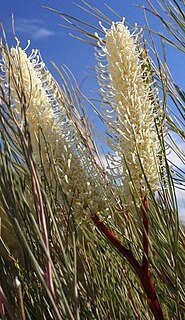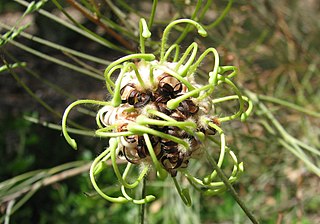
Grevillea miniata, commonly known as the sandstone grevillea, is a shrub or small tree between 1.8 and 5 metres in height which is native to Western Australia and the Northern Territory. It has yellow or orange flowers and holly-like leaves.

Grevillea candelabroides is a shrub or small tree which is endemic to sandy heathland between Geraldton and Shark Bay in Western Australia.

Grevillea tetragonoloba is an erect or spreading shrub which is endemic to Western Australia. The red or brown "toothbrush" flowers appear between early winter and late spring. The species occurs in an area between Albany and Esperance on sandy or loam soils. It grows to between 0.6 and 2.6 m high.

Grevillea levis is a shrub which is endemic to Western Australia. It grows to between 1 and 2 metres in height and produces flowers which are white or cream, flushed with pink, in late autumn to mid spring. The species was first formally described by Olde & Marriott in 1994 from a type specimen collected from Mount Churchman. It occurs in south-western Western Australia in open heath and shrubland.

Grevillea excelsior, commonly known as flame grevillea, is a small tree which is endemic to Western Australia. It usually grows to a height of between 2 and 8 metres and produces yellow or orange flowers between July and January in its native range.

Grevillea involucrata, also known as Lake Varley grevillea, is a low-growing shrub which is endemic to the south-west of Western Australia. It grows up to 0.5 metres in height and produces pink flowers between June and October in its native range.

Grevillea erectiloba is a shrub which is endemic to Western Australia. It usually grows to a height of between 1 and 3 metres and produces red flowers between September and October in its native range.
Grevillea candicans is a shrub which is endemic to the south-west of Western Australia. It usually grows to between 1 and 5 metres in height and produces white or cream flowers between August and October in its native range.
Grevillea paniculata is a shrub which is endemic to the south-west of Western Australia. It grows to between 0.6 and 3 metres in height and produces white, cream or yellow flowers between June and November in its native range.
Grevillea annulifera, also known as prickly plume grevillea, is a shrub which is endemic to Western Australia. It grows to between 1 and 4 metres in height and produces white, cream or yellow flowers between June and October in its native range.

Grevillea endlicheriana, also known as spindly grevillea, is a shrub which is endemic to the southwest of Western Australia.

Grevillea ripicola, commonly known as Collie grevillea, is a shrub which is endemic to the south west region of Western Australia. It grows to between 0.6 and 2 metres in height and up to 4 metres in width. The species was first formally described by botanist Alex George in Nuytsia in 1974 based on plant material collected at Collie. It is classified as Priority Four Flora (Rare) under the Wildlife Conservation Act in Western Australia.

Grevillea pimeleoides is a shrub which is endemic to the south west region of Western Australia.

Actinobole is a genus of dwarf annual herbs in the family Asteraceae described as a genus in 1843.

Acidonia microcarpa is a species of shrub in the plant family Proteaceae. It is the only species in the genus Acidonia. It is endemic to the south coast of the Southwest Botanic Province of Western Australia.

Grevillea pinaster is a shrub in the family Proteaceae. It is endemic to south-western Western Australia.
Grevillea acacioides, is a shrub which is endemic to Western Australia.
Grevillea acropogon is a shrub which is endemic to the south-west of Western Australia.

Grevillea globosa is a shrub in the family Proteaceae. It is endemic to Western Australia, occurring in the northern wheatbelt.

Actinobole uliginosum, the flannel cudweed, is a species of dwarf annual herb in the family Asteraceae, which is endemic to Australia. It occurs in every state of mainland Australia.














